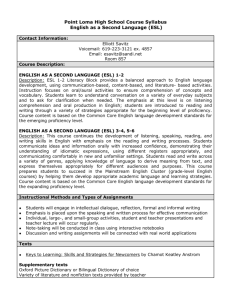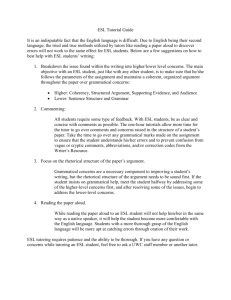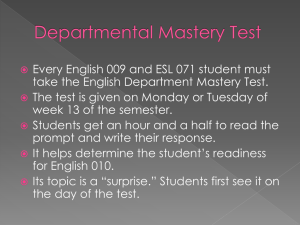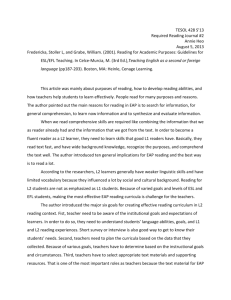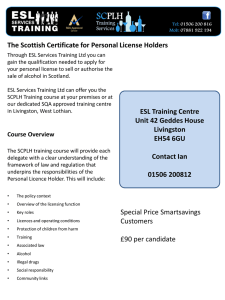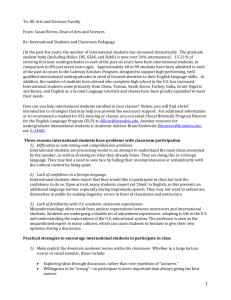First Day Strategies for ESL students
advertisement
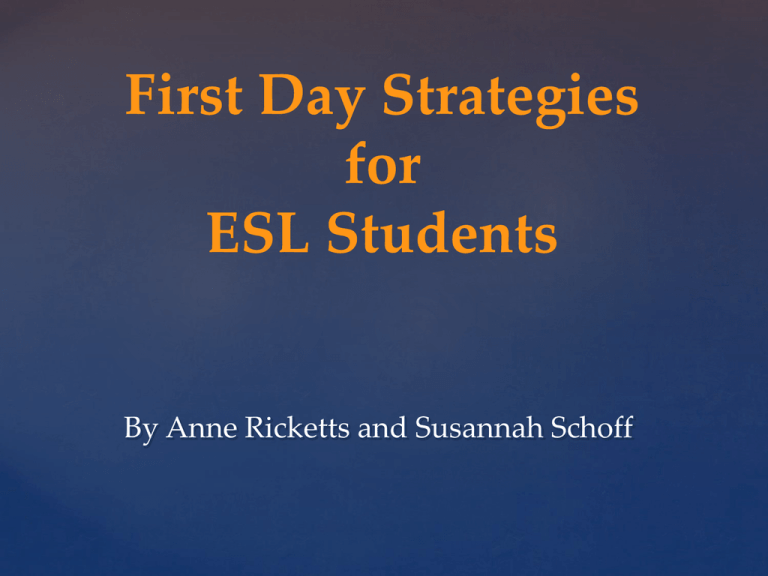
By Anne Ricketts and Susannah Schoff Workshop Goals Share what we know about our international students Discuss challenges we all face with international students in our classes Share strategies for meeting students’ and teachers’ needs to encourage more engaging, interactive, and successful lessons 1. Act/react in the “first day of class” simulation the way you think a student would. 2. Be ready to discuss your reactions and challenges after the simulation. Psychology of Prismatology and Reflective Logistics FND 807 Detailmatography Logistics High Society Cecily Brown First Day of Class: Prepared Participation and Group Discussion 1. How did you feel during the simulation? 2. What was challenging for you? Why? Understanding our International Population 22% total student population 32% online student population 21% Chinese 19% Korean 17% Taiwanese 5% Thai 4% Indonesian 1% Saudi (39 total) Understanding the Cultural Backgrounds… Growing middle class in Asia •Many only-children from China •First experience living away from parental control/abroad •Tend to stick with students from same country •More Saudi Arabian students coming (Higher oral/lower writing) • Limited experience using English in social and academic settings •Some embarrassed to be labeled ‘ESL’ • Different Expectations… International Students’ home countries vs. Academy of Art Memorization and teacher-focused classes vs. critical thinking and active student participation • • Stricter classroom hierarchy vs. informal setting • Using other’s ideas=respect for others’ opinions vs. Plagiarism = F Snapshot of our ESL Program • EAP = English for Art Purposes • EAP 1 = Advanced beginner EAP 2 = Low Intermediate EAP 3 = Intermediate EAP 4 = High Intermediate (most advanced) LA 103= Fundamentals of English Writing LA 106=Speaking & Listening for Artists • • • • • *Grad level= 601, 602, 603, & 604 The Flip Side: Challenges you face In groups of 3-4, make a list of challenges you’ve experienced (or predict you may experience in the fall) with your international students in the classroom. For example: 1. Lack of Participation 2. 3. Our Bag of ESL Tricks For the first day and beyond Challenge #1: Students don’t understand important information and directions Solutions for Understanding Information and Directions: 1. Repetition is your friend! 2. Make key words and directions VISUAL: write them on the board or on handouts 3. Ask Effective Comprehension Questions a. Ask during class and at the end b. Yes/No vs. WhE.g. “Do you understand the homework? Vs. “ What will you do for homework?” c. Wait 5+ seconds for responses. Challenge #2: Students don’t participate in class or small group discussions Solutions for More Participation: 1. Prepared Participation Written or in pairs/small groups before whole class discussions. 2. Ask effective questions and never say “Good!” when no one has any. Solutions for More Participation Cont. 3. Grouping: a. Mix domestic with foreign students b. Count off by numbers c. Create half circle vs. rows 4. Create firm expectations for participation starting first day E.g. Everyone must ask 1 question or share one idea each class Challenge #3: You and your students aren’t using the ESL Support Teacher Solutions for Using the Support Teacher: 1. Communicate with your support teachers. 2. Allow ESL support to write vocabulary words on the board while you talk- reduces time lapse, ensures better understanding. 3. Give time during and at end of class for ESL teacher to clarify/circulate. 4. Strongly encourage study group. Challenge #4: Students don’t critique effectively Solutions for Effective Critiques: 1. 2. Model ‘The Critique Sandwich’ a. Positive feedback b. Negative or suggestions c. Finish with positive Teach/Review useful language and criteria: Students need to know more than just “I like it.” E.g. “The layout is successful because…” “The color scheme is not effective because…” What will you do to maximize your ESL students success on the first day of class? Prepared Participation: Talk about one activity you plan to do on the first day of class 1. Brainstorm possible challenges 2. Brainstorm possible solutions Experiment with these strategies… Start on the first day….and remember “Repetition is your friend!” • • Expect some successes and some difficulties as you adjust • Please contact us with any questions/comments Smschoff@gmail.com aricketts@academyart.edu Thank You Any questions?


